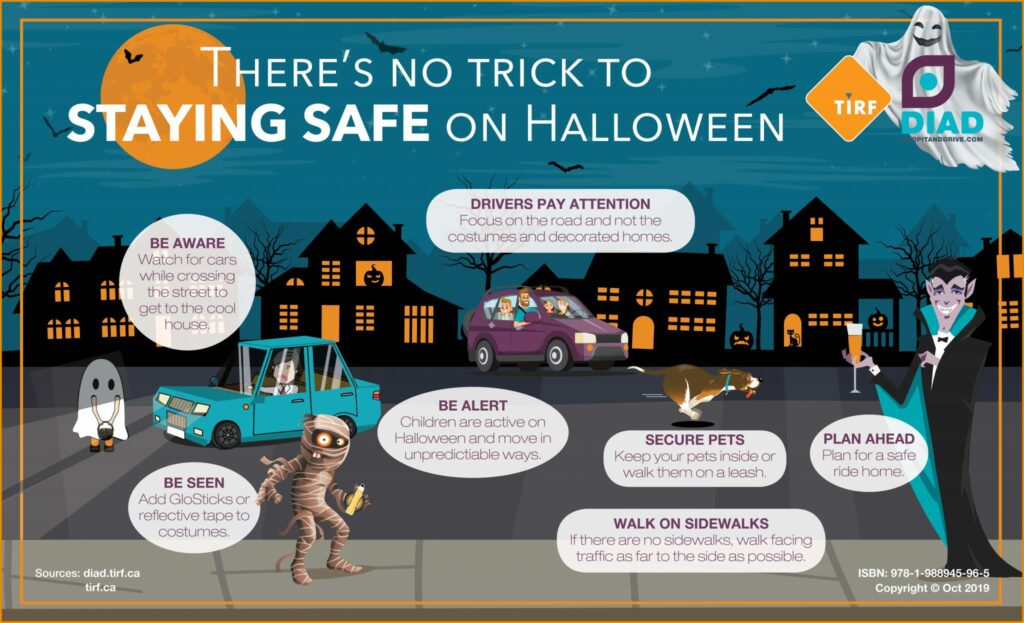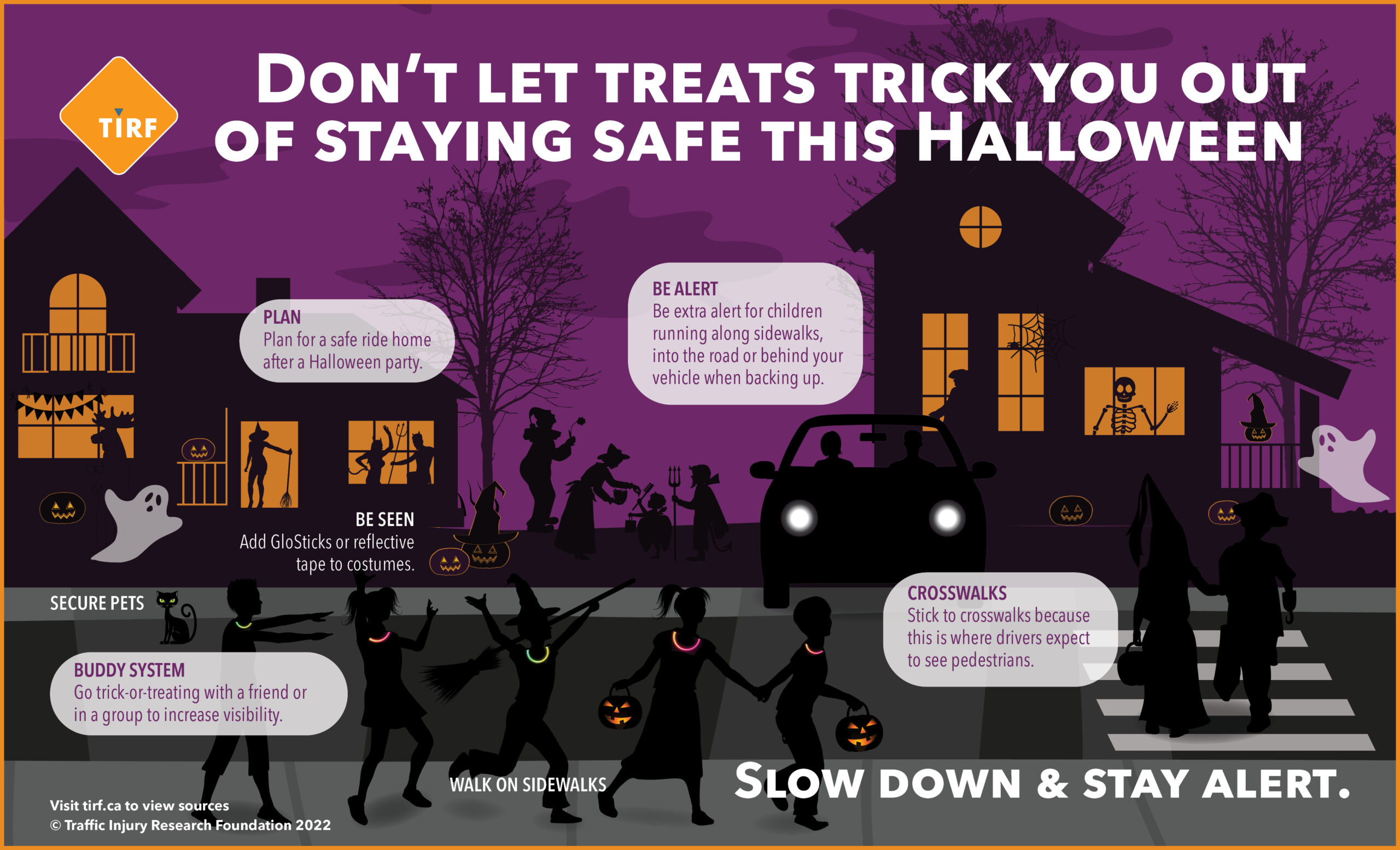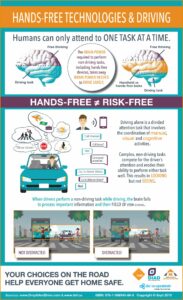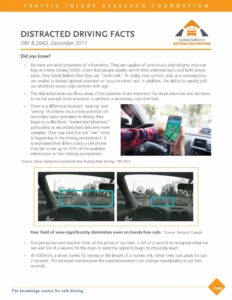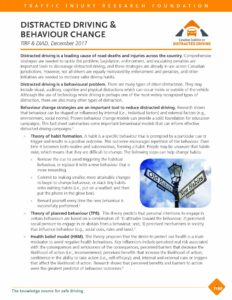Note: Be sure to also check out our 2022 Halloween blog & new infographic: Don’t let your treats trick you out of staying safe this Halloween
This Halloween let’s work together to keep the streets safe for everyone.
On October 31st, countless kids in costumes as ghosts, ghoulies, goblins, witches/wizards and the latest pop culture trends will be excitedly running from house to house in search of tasty treats. We all know younger pedestrians are at greater risk of injury or death because of their smaller size and their auditory, visual and cognitive senses are less developed. This Halloween let’s work together to keep the streets safe for everyone.
If you will be driving on Halloween, remember driving is a divided attention task involving the coordination of manual, visual and cognitive activities. Complex, non-driving-related tasks compete for a driver’s attention and impede their ability to perform either task well. This results in drivers looking at the road but not seeing everything that is on the road. As drivers, we need to pay attention to the road and not the costumes or decorated homes in our neighbourhoods. Ensuring a safe Halloween for everyone means we all have to make sure we don’t miss persons and movements around us.
Pedestrian road fatalities are consistent throughout the year, but some characteristics are particularly concerning at Halloween. This is due to the time of day of most celebrations, the young age of pedestrians navigating neighbourhood streets, and the temptation of trick or treaters to unpredictably cross over roads:
- 6 in 10 pedestrians killed in traffic crashes were trying to cross the road
- 6 in 10 pedestrians were killed at night or in dim light conditions
- 6% of fatally injured pedestrians were under age 16; of these, 20% ran out into the street
It is not only younger road users that are at risk on Halloween. October 31st is also an opportunity for all generations to release their inner alter ego. Halloween celebrations historically extend to the young-at-heart and often involve party-goers who may be served alcoholic beverages.
The Traffic Injury Research Foundation’s annual Road Safety Monitor on drinking and driving in Canada reported one-third of respondents reported doing most of their drinking in the company of close friends (33.3%) or a life partner and/or family member (33.1%). As those who care most about our family and friends, we have the opportunity to pre-arrange safe rides or designate drivers. There will undoubtedly be memorable moments or costumes worthy of reliving for days and weeks following October 31st. Helping each other secure safe rides home will ensure those stories focus on fun instead of a moment’s decision that can lead to a lifetime of regret.
Taking a few basic precautions can help ensure Halloween remains a treat to be enjoyed by everyone.
Drop It And Drive® Halloween Safety TIPS for All Ages & Species
Drivers/Party Goers
- Plan for a safe ride home or plan to stay over and avoid driving after drinking
- Designate a passenger as your texter to update on ETA or to get directions
- Don’t let the display of costumes & decorated homes distract you from paying attention to the road
- Slow WAY down in residential neighbourhoods – kids are excited and impulsive and may suddenly run across the road. YES, we know they shouldn’t, but we also know they WILL
- Enter and exit driveways, laneways & alleys with extra caution
- Be a responsible party host – make sure driving guests leave sober or have a safe ride if they have been drinking
- Ensure costume weapons are easily identifiable as toys
Trick or Treaters
- Don’t dash across the road to get the ‘cool’ house – watch for cars ALWAYS
- Stay in a group – do not Trick or Treat alone
- Never go into a house no matter how tempting it is
- If trick or treating with parents, keep them in sight at all times – don’t run ahead
- Make sure you can see clearly through masks or headgear
- Only go to homes with the lights on – if their lights are off, respect that they’re not home or are not participating in Halloween
- Don’t eat any of your candy without having parents check it first
Parents
Ensure kids costumes make them visible – if not, add GloSticks or reflective tape and/or have them carry a flashlight or LED lights (most dollar stores, craft stores, sporting goods stores and big box stores carry these items)
- Have a safety plan in place if you get separated from your young trick or treaters (meeting place, cell phone communication, call 911, ensure they DO NOT enter a stranger’s home to use their phone EVER, etc.)
- Use makeup as much as possible in lieu of masks or headgear to ensure kids can see clearly
- Remind kids to be careful when crossing over driveways, laneways & alley entryways
- As in years past, check kids’ candy before letting them eat it – throw away opened or suspicious candy
Pet Owners
Halloween is a great night to keep pets INSIDE
- Ensure pets are secure when opening the door for trick or treaters
- Sadly, black cats are at particular risk for injury and assault
- Firecrackers & fireworks often spook animals resulting in them escaping from your yard or getting away from you while walking them
- Walk your dogs on a leash – even if you can normally walk your dog off-leash, Halloween is NOT the night to do so
- Secure livestock and large animals (horses, cows, llamas, pigs, etc.) INSIDE the barn where possible
Share your best Halloween safety tips in the comments.
Download this helpful mini infograhic available in JPG or PDF.
Also, download our newest Halloween infographic in PDF or JPG from our 2022 Don’t let your treats trick you out of staying safe this Halloween blog:
#MySafeRoadHome blog authors: Robyn Robertson, President & CEO and Karen Bowman, Director, Drop It And Drive® (DIAD) program, have worked collaboratively, drawing from Robyn’s breadth of knowledge on the topic combined with Karen’s blogging background and experience leading the DIAD program since 2010. Robyn is the author of TIRF’s knowledge translation model, is well-versed in implementation strategies and operational practices across several sectors. To date, the DIAD program has been delivered to more than 60,000 youth and workers across North America.
References:
Road Safety Issues, Pedestrians: What Do We Know?, 2015, Traffic Injury Research Foundation https://tirf.ca/TIRFTK09
Sharing the Road: Pedestrians & Vehicles, 2018, Traffic Injury Research Foundation https://tirf.ca/TIRFCAD18M
Transport Canada https://www.tc.gc.ca/eng/motorvehiclesafety/tp-tp15145-1201.htm#s38
Road Safety Monitor 2018: Drinking and Driving in Canada https://tirf.ca/TIRFCAD18CCC
Related topics:
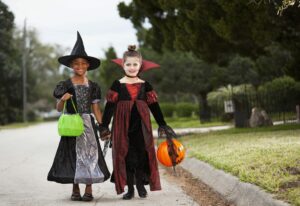


 Halloween is a great night to keep pets INSIDE
Halloween is a great night to keep pets INSIDE